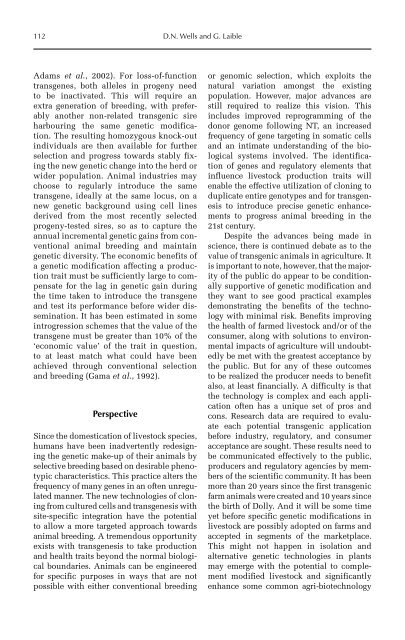Redesigning Animal Agriculture
Redesigning Animal Agriculture
Redesigning Animal Agriculture
Create successful ePaper yourself
Turn your PDF publications into a flip-book with our unique Google optimized e-Paper software.
112 D.N. Wells and G. Laible<br />
Adams et al., 2002). For loss- of-function<br />
transgenes, both alleles in progeny need<br />
to be inactivated. This will require an<br />
extra generation of breeding, with preferably<br />
another non-related transgenic sire<br />
harbouring the same genetic modification.<br />
The resulting homozygous knock-out<br />
individuals are then available for further<br />
selection and progress towards stably fixing<br />
the new genetic change into the herd or<br />
wider population. <strong>Animal</strong> industries may<br />
choose to regularly introduce the same<br />
transgene, ideally at the same locus, on a<br />
new genetic background using cell lines<br />
derived from the most recently selected<br />
progeny-tested sires, so as to capture the<br />
annual incremental genetic gains from conventional<br />
animal breeding and maintain<br />
genetic diversity. The economic benefits of<br />
a genetic modification affecting a production<br />
trait must be sufficiently large to compensate<br />
for the lag in genetic gain during<br />
the time taken to introduce the transgene<br />
and test its performance before wider dissemination.<br />
It has been estimated in some<br />
introgression schemes that the value of the<br />
transgene must be greater than 10% of the<br />
‘economic value’ of the trait in question,<br />
to at least match what could have been<br />
achieved through conventional selection<br />
and breeding (Gama et al., 1992).<br />
Perspective<br />
Since the domestication of livestock species,<br />
humans have been inadvertently redesigning<br />
the genetic make-up of their animals by<br />
selective breeding based on desirable phenotypic<br />
characteristics. This practice alters the<br />
frequency of many genes in an often unregulated<br />
manner. The new technologies of cloning<br />
from cultured cells and trans genesis with<br />
site-specific integration have the potential<br />
to allow a more targeted approach towards<br />
animal breeding. A tremendous opportunity<br />
exists with transgenesis to take production<br />
and health traits beyond the normal biological<br />
boundaries. <strong>Animal</strong>s can be engineered<br />
for specific purposes in ways that are not<br />
possible with either conventional breeding<br />
or genomic selection, which exploits the<br />
natural variation amongst the existing<br />
population. However, major advances are<br />
still required to realize this vision. This<br />
includes improved reprogramming of the<br />
donor genome following NT, an increased<br />
frequency of gene targeting in somatic cells<br />
and an intimate understanding of the biological<br />
systems involved. The identification<br />
of genes and regulatory elements that<br />
influence livestock production traits will<br />
enable the effective utilization of cloning to<br />
duplicate entire genotypes and for transgenesis<br />
to introduce precise genetic enhancements<br />
to progress animal breeding in the<br />
21st century.<br />
Despite the advances being made in<br />
science, there is continued debate as to the<br />
value of transgenic animals in agriculture. It<br />
is important to note, however, that the majority<br />
of the public do appear to be conditionally<br />
supportive of genetic modification and<br />
they want to see good practical examples<br />
demonstrating the benefits of the technology<br />
with minimal risk. Benefits improving<br />
the health of farmed livestock and/or of the<br />
consumer, along with solutions to environmental<br />
impacts of agriculture will undoubtedly<br />
be met with the greatest acceptance by<br />
the public. But for any of these outcomes<br />
to be realized the producer needs to benefit<br />
also, at least financially. A difficulty is that<br />
the technology is complex and each application<br />
often has a unique set of pros and<br />
cons. Research data are required to evaluate<br />
each potential transgenic application<br />
before industry, regulatory, and consumer<br />
acceptance are sought. These results need to<br />
be communicated effectively to the public,<br />
producers and regulatory agencies by members<br />
of the scientific community. It has been<br />
more than 20 years since the first transgenic<br />
farm animals were created and 10 years since<br />
the birth of Dolly. And it will be some time<br />
yet before specific genetic modifications in<br />
livestock are possibly adopted on farms and<br />
accepted in segments of the marketplace.<br />
This might not happen in isolation and<br />
alternative genetic technologies in plants<br />
may emerge with the potential to complement<br />
modified livestock and significantly<br />
enhance some common agri- biotechnology










